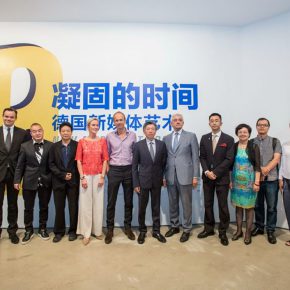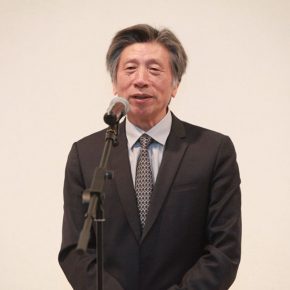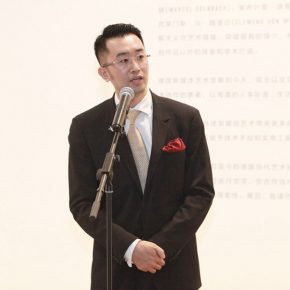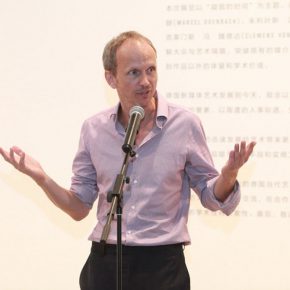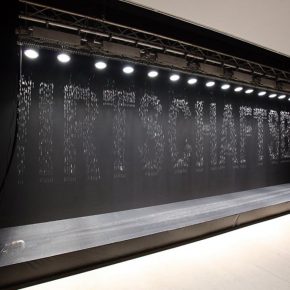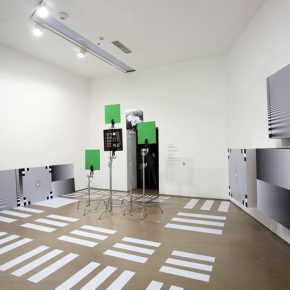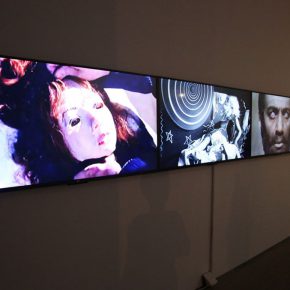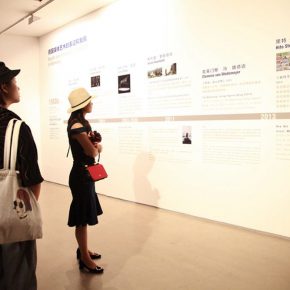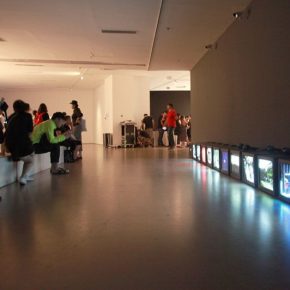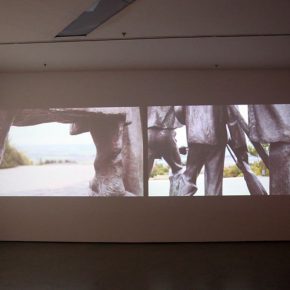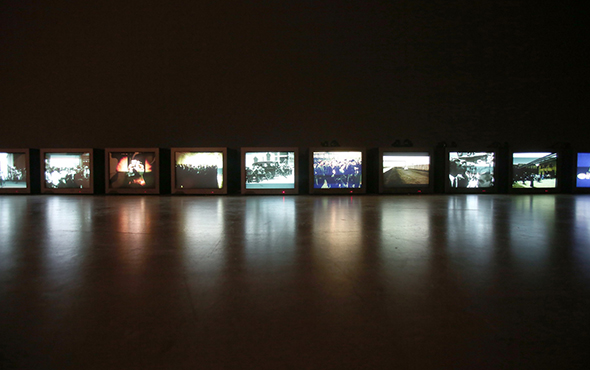
At 11:00 on September 17, 2017, “Arrested Time: New Media Art from Germany” of “Deutschland 8: Deutsche Kunst in China” project opened at Building 2 of Today Art Museum. Prof. Fan Di’an, President of Central Academy of Fine Arts and a general curator for “Deutschland 8”, Prof. Dr. Walter Smerling, Chairman of the Stiftung für Kunst und Kultur e.V and a general curator for “Deutschland 8”, Gao Peng, Deputy Curator of “Deutschland 8” and Director of Today Art Museum, and the representative of the German artists Julian Rosefeldt and other honored guests attended the opening ceremony.
The exhibition focuses on the basic development traces of German media art, highlighting important stages and representing artists by exhibiting representative works of seven of the most famous and active new media artists in Germany, including Harun Farocki, Julian Rosefeldt, Hito Steyerl, Clemens von Wedemeyer, Marcel Odenbach, Jürgen Klauker and Julius Popp, to show the characteristics of the new media art and the face of German image art.
Entering the main exhibition hall, one first sees the work “bit.fall” by Julius Popp, conceived between 2003 and 2006 for interior and exterior spaces both in the public sphere and in a museum, which heralds the age of digital art – or to be exact, the era of digital art as a reflection of nature. The natural element of water is sequenced into individual drops in a combination of engineering and computer art. The fall of the droplets can be precisely controlled. This computed reality manifests itself as writing in space, with the water droplets forming each letter. With the works of Hito Steyerl and Julius Popp we are entering the horizon of computer-assisted digital art, the latest form of visual media art.
The installation of “How Not to Be Seen: A Fucking Didactic Educational. MOV File 2013” finished in 2013 by Hito Steyerl reflects mischievously on the genre of educational video and YouTube tutorials. In this brash and colorful spectacle, it takes the viewer on a journey from playful pixel manipulations to green-screen effects, before finally arriving in the desert at an abandoned military photo-calibration field, which is as if walking through the world of digital and film technology. Steyerl addresses today’s omnipresent surveillance architecture by deconstructing the art of camouflage. She creates an optical game of deception from which the viewer can only find egress through his or her own initiative. Here perhaps is the moment to point out that the cited artists are steeped in the tradition of German idealism, ie. of the Enlightenment, despite the occasional Romantic overtones.
The political character of the first generation of video artists is underscored most forcefully in the work of Harun Farocki. Farocki’s video installation “Workers Leaving the Factory in Eleven Decades” from 2006 comprises 12 monitors connected in parallel. In this 36-minute sequence of video images, it begins with Lumières’s “La Sortie de l'usine Lumière à Lyon (Workers Leaving the Factory)” from 1895, depicting different variants of workplace situations drawn from the history of film. This piece was produced for the exhibition “Cinema like Never Before” organized by the Generali Foundation in Vienna in 2006.
Consisting of seven interactive plasma screens, the work by Jürgen Klauke “I Go I Stand” from 2003, documents, on the one hand, the action-theatre typical of the artist, whose sense of being body-centred continually interrogates gender identity and challenges the norms of social conventions. On the other hand, its installation character serves to transform the documentation into an autonomous video installation. This work also casts the spotlight on a phenomenon that originates back in the 1970s: the progression from the playing of videotapes on one monitor to a multichannel installation comprising several monitors.
Marcel Odenbach prefers to explore the socially encoded norms informing our perception of memory. Conceived especially for the Vienna Kunsthalle in 2016, Odenbach’s 2-channel video installation “Proof of Nothing” takes as its subject the memorial designed in 1951 by Fritz Cremer for the former Buchenwald Concentration Camp on Mount Ettersberg near Weimar, which was erected between 1954 and 1958. In the approximate 15-minute film encounter with the monument, Odenbach studies the question of how memory and history are visualized and idolized. The title of Odenbach’s work alludes to Ingeborg Bachmann’s eponymous poem.
The 30-minute, 4-channel video installation “My Home Is a Dark and Cloud-Hung Land” from 2011, is of a title that alludes to a quote from the philosopher Theodor Lessing. Julian Rosefeldt excavated the archaeology of German history. The forest features as a dramatized place, whose cultural complexity is staged and commented on as a theatrical combination of literature, song extracts and sound atmospheric, romantically charged as the embodiment of a natural paradise and impassioned nationalist sentiment. In Rosefeldt’s work, the traces of painting, as once primary mediums shaping the Romantic-Nationalist concept of history, are expunged. This autonomous form of video art was Rosefeldt’s response to the narrative of cinematography.
A similar approach to this new terrain, positioned between theatrical dramatization, documentation and essay like voice-over, between dystopia and utopia, is adopted in the work of Clemens von Wedemeyer. The work of video installation of “The Beginning, Living Figures Dying” from 2013, is the work that combines the re-edited classic scenes of works in the history of film. The film is distributed on five screens, with a 6-second off-set time between each screen. It reveals how the sculpture & its production, worship and destruction are presented in the form of film.
The exhibition breaks through the original media, and a single art is presented in the public view through a variety of ways of presentation, as the carrier bears concepts, it is a thematic research of contemporary German art since the post-war, so that people feel the volume and academic value beside the works. At the same time, it is also an opportunity for the Chinese public to appreciate the complete and unique German video art, to have a communication on the cultural characteristics of the two countries, mutually understanding and learning in the cooperation. During the exhibition it also holds academic seminars and public educational projects for a complete demonstration of the academic nature and exploratory nature of German contemporary art.
It remains on view till November 12, 2017.
Text edited by Zhong Yuwei, translated by Chen Peihua and edited by Sue/CAFA ART INFO
Photo courtesy of the organizer


